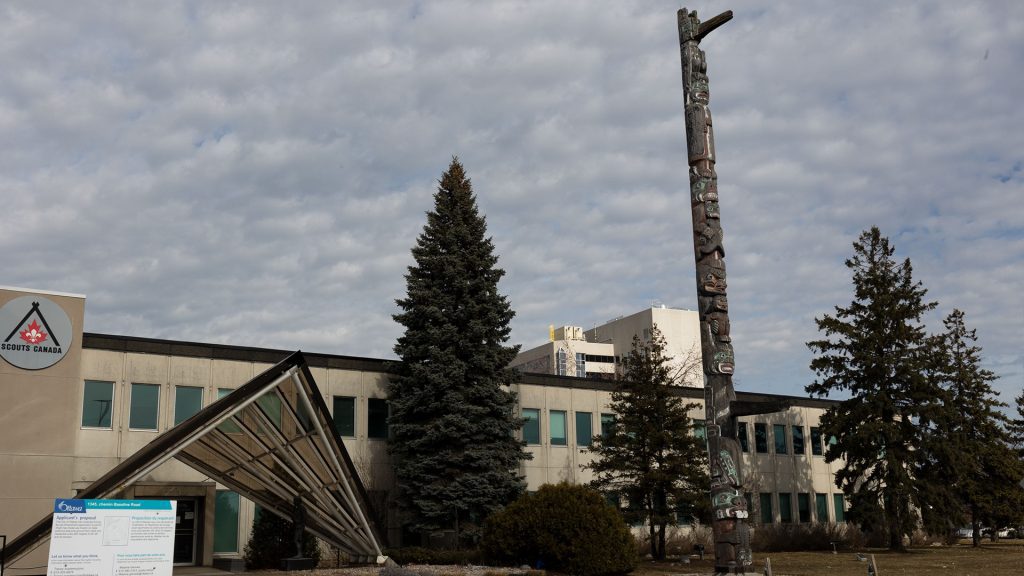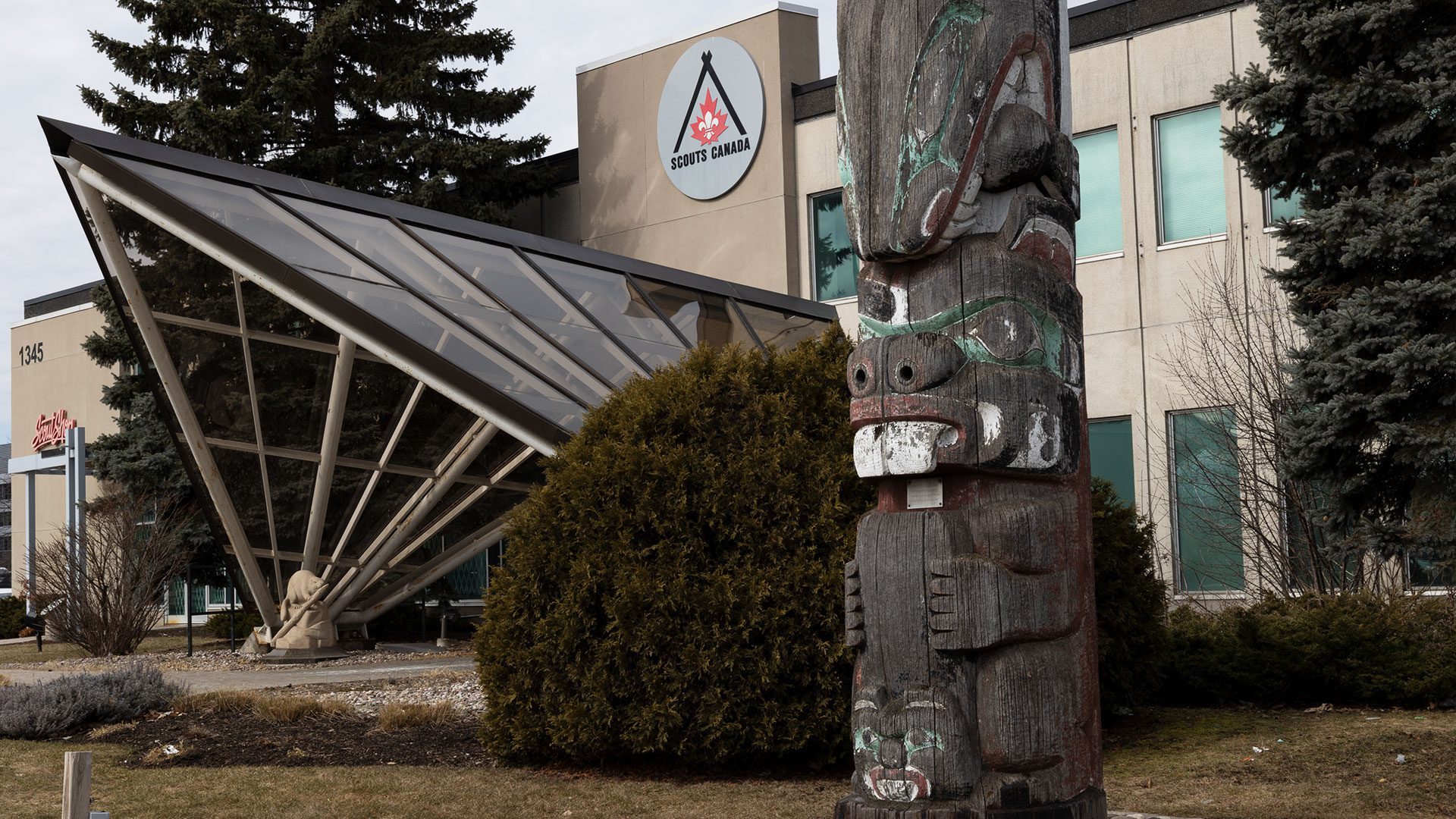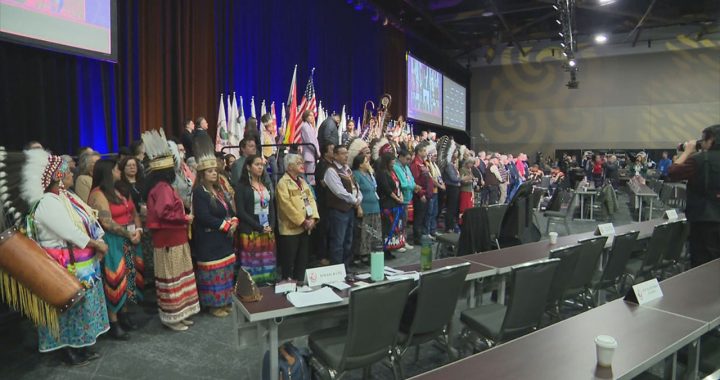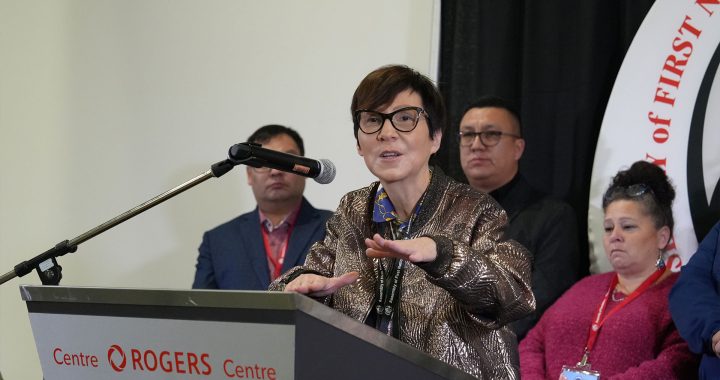
The totem pole at Scouts Canada headquarters in Ottawa was donated by the B.C. government in the 1960s. Photo: Kerry Slack/APTN.
A First Nation in B.C. wants a totem pole that sits outside of the former Scouts Canada headquarters in Ottawa returned.
The totem pole, gifted to the Scouts Canada by the Scouts chapter in B.C. in 1961, was carved by former Kwakwaka’wakw Nation chief and world-renowned carver Mungo Martin.
“We are planning on building a Mungo Martin Totem Memorial Park out here, so, I suggested they box it up and we can repatriate it back to nature in our memorial park,” said Hereditary Chief David Knox.
The pole is showing signs of age and neglect. There is barely any visible paint and a single crack runs from the bottom to the top. The scouts are currently selling the property for condominiums – and the City of Ottawa is planning on developing the area for rapid transit.

With the impending development, the totem pole finds itself in the way of both prompting conversations around its preservation and restoration.
Scouts Canada told APTN News that it remains committed to ensuring the totem pole’s refurbishment is done in a manner that honours its cultural significance and Indigenous roots.
“In 2022, we were engaging the family of Chief Mungo Martin on how best to honour the legacy of the totem pole in a culturally appropriate way,” said Anissa Stambouli, associate director of communications with Scouts Canada in an email to APTN.
“We continue to stay connected with his family, are committed to respecting their wishes and have been exploring options to have the totem pole restored in collaboration with the family.”
According to an article written by historian Allison Smith of Heritage Ottawa, the totem pole was commissioned and paid for by the Provincial Museum of British Columbia, now called the Royal BC Museum and “other commercial and industrial sources” for $8000. It stands 20 metres and has six parts. From top to bottom, raven, man, grizzly, bear, cannibal woman, killer whale and beaver. These six clan crests represent the founders of these clans, indicating their change in form from animal to human.
Martin died in 1962 at the age of 83. His grandson, Richard Hunt, remembers his grandfather well.
“We used to go to his house in Victoria all the time and have tea together. We were together all the time. Because we were with him in Victoria, we were big into potlaching. We were really into our culture,” said Hunt.
“I was 11 when he passed away, so I remember [him] carving some of the masks.”

But there are questions whether the decades old totem pole would even make the journey to Kwakiutl First Nation located at the north end of Vancouver Island.
“Scouts Canada still owns the property, ultimately, it’s up to the Scouts whether it remains on the site. The challenge is the condition of the totem pole,” said Riley Brockington, deputy mayor and councillor for the area.
“It’s very weathered, so, last time I spoke with the Scouts they weren’t sure if it would survive a transplant but they very much respect and appreciate the totem pole.”
According to Scouts Canada, plans are in motion to find a suitable new home for the totem pole, either within a proposed public park space or as part of a future redevelopment of the property.
Hunt would love to come assess its condition.
“Maybe somebody would fly me out there [Ottawa] and I could go look at it,” said Hunt. “I mean that is what we do with our poles. On the reserve, or the village that I come from we just let the pole fall down and let it rot again, or go back to the earth, and sometimes we burn them,” said Hunt.
“That’s what we’d do.”
A decision has not yet been made on the fate of the totem pole.
“While no next steps have been decided on regarding the totem pole and as we get closer to a purchase and sale agreement on the Baseline office property, we anticipate these conversations with the family will increase in engagement,” said Stambouli.

The family wants to see the totem maintained, wherever it ends up.
“I’ve always said that if it’s in the public domain our totem poles should be maintained,” said Hunt. “Instead of just letting them sit there for years.”
This isn’t the only totem pole carved by the family that sits in Ottawa. In the city’s downtown Confederation Park, a totem carved by another grandson of Martin’s, Henry Hunt, sits with a plaque which “commemorates the century union of the province of British Coumbia with Canada, July 20, 1871.”










